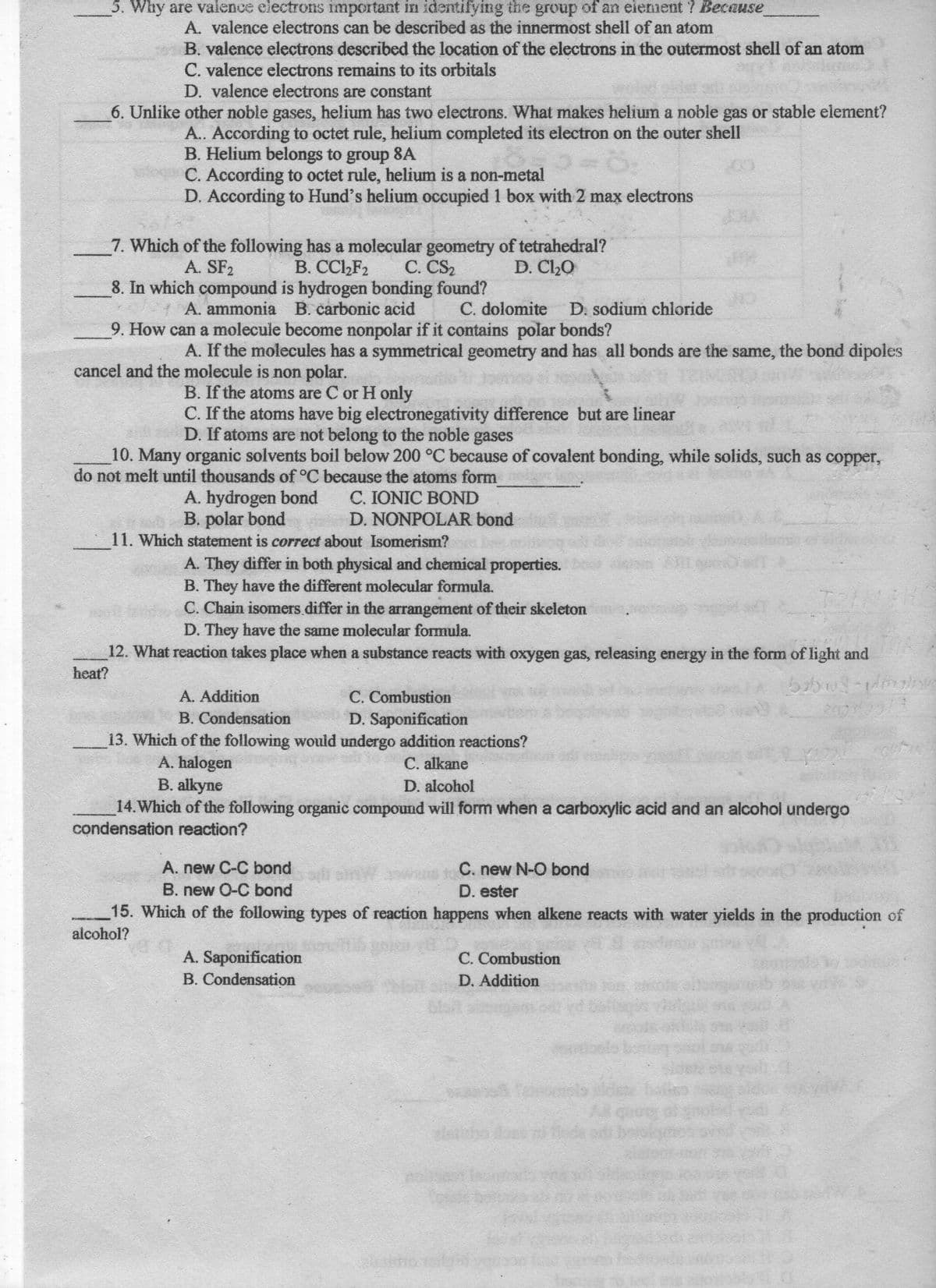Introductory Chemistry: A Foundation
9th Edition
ISBN:9781337399425
Author:Steven S. Zumdahl, Donald J. DeCoste
Publisher:Steven S. Zumdahl, Donald J. DeCoste
Chapter12: Chemical Bonding
Section: Chapter Questions
Problem 47CR: Which of the following statements is correct and provides the best explanation when removing the...
Related questions
Question
MULTIPLE CHOICE
13-15 ONLY

Transcribed Image Text:5. Why are valence electrons important in identifying the group of an element ? Because
A. valence electrons can be described as the innermost shell of an atom
B. valence electrons described the location of the electrons in the outermost shell of an atom
C. valence electrons remains to its orbitals
D. valence electrons are constant
6. Unlike other noble gases, helium has two electrons. What makes helium a noble gas or stable element?
A.. According to octet rule, helium completed its electron on the outer shell
B. Helium belongs to group 8A
C. According to octet rule, helium is a non-metal
D. According to Hund's helium occupied 1 box with 2 max electrons
7. Which of the following has a molecular geometry of tetrahedral?
B. CCl,F2
D. C20
С. CS2
8. In which compound is hydrogen bonding found?
A. ammonia B. carbonic acid
A. SF2
C. dolomite
D. sodium chloride
9. How can a molecule become nonpolar if it contains polar bonds?
A. If the molecules has a symmetrical geometry and has all bonds are the same, the bond dipoles
cancel and the molecule is non polar.
B. If the atoms are C or H only
C. If the atoms have big electronegativity difference but are linear
D. If atoms are not belong to the noble gases
10. Many organic solvents boil below 200 °C because of covalent bonding, while solids, such as copper,
do not melt until thousands of °C because the atoms form
A. hydrogen bond
B. polar bond
11. Which statement is correct about Isomerism?
C. IONIC BOND
vi D. NONPOLAR bond
A. They differ in both physical and chemical properties.
B. They have the different molecular formula.
C. Chain isomers differ in the arrangement of their skeleton
D. They have the same molecular formula.
12. What reaction takes place when a substance reacts with oxygen gas, releasing energy in the form of light and
heat?
C. Combustion
D. Saponification
A. Addition
200 1
B. Condensation
13. Which of the following would undergo addition reactions?
A. halogen
B. alkyne
14.Which of the following organic compound will form when a carboxylic acid and an alcohol undergo
C. alkane
D. alcohol
condensation reaction?
A. new C-C bond
C. new N-O bond
B. new O-C bond
D. ester
15. Which of the following types of reaction happens when alkene reacts with water yields in the production of
alcohol?
A. Saponification
B. Condensation
C. Combustion
D. Addition
Expert Solution
This question has been solved!
Explore an expertly crafted, step-by-step solution for a thorough understanding of key concepts.
This is a popular solution!
Trending now
This is a popular solution!
Step by step
Solved in 3 steps

Knowledge Booster
Learn more about
Need a deep-dive on the concept behind this application? Look no further. Learn more about this topic, chemistry and related others by exploring similar questions and additional content below.Recommended textbooks for you

Introductory Chemistry: A Foundation
Chemistry
ISBN:
9781337399425
Author:
Steven S. Zumdahl, Donald J. DeCoste
Publisher:
Cengage Learning

Chemical Principles in the Laboratory
Chemistry
ISBN:
9781305264434
Author:
Emil Slowinski, Wayne C. Wolsey, Robert Rossi
Publisher:
Brooks Cole


Introductory Chemistry: A Foundation
Chemistry
ISBN:
9781337399425
Author:
Steven S. Zumdahl, Donald J. DeCoste
Publisher:
Cengage Learning

Chemical Principles in the Laboratory
Chemistry
ISBN:
9781305264434
Author:
Emil Slowinski, Wayne C. Wolsey, Robert Rossi
Publisher:
Brooks Cole


Introductory Chemistry: A Foundation
Chemistry
ISBN:
9781285199030
Author:
Steven S. Zumdahl, Donald J. DeCoste
Publisher:
Cengage Learning

Chemistry for Engineering Students
Chemistry
ISBN:
9781337398909
Author:
Lawrence S. Brown, Tom Holme
Publisher:
Cengage Learning

Chemistry for Engineering Students
Chemistry
ISBN:
9781285199023
Author:
Lawrence S. Brown, Tom Holme
Publisher:
Cengage Learning